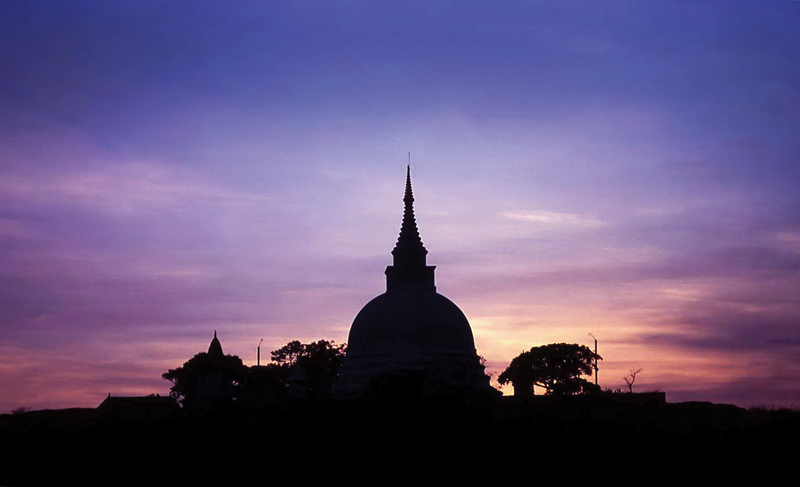Located 40 kilometres North-West of Anuradhapura, spread across closely strewn rock surfaces surrounded by dense jungle, the genesis of this ancient temple is traced to Third Century BCE. Used in later years as a monastery, Thanthirimale is renowned for its many caves, inscriptions, carvings, ruins of monastic residences, meditation chambers, a library and of course, the Sacred Bo tree
 Commemorating the arrival of Buddhism in Sri Lanka, the sacred precincts of Thanthirimale Raja Maha Vihara at Maha Wilachchiya about 40 kilometres North-West of Anuradhapura, illuminated this full moon Poson Poya day and welcomed thousands of devotees.
Commemorating the arrival of Buddhism in Sri Lanka, the sacred precincts of Thanthirimale Raja Maha Vihara at Maha Wilachchiya about 40 kilometres North-West of Anuradhapura, illuminated this full moon Poson Poya day and welcomed thousands of devotees.
For three decades, Thanthirimale being a border village lay in the Wilpattu National Park, often deserted. It was a safe haven for the LTTEers who are believed to have come via Thanthirimale to attack the sacred Jaya Sri Maha Bodhi in Anuradhapura.
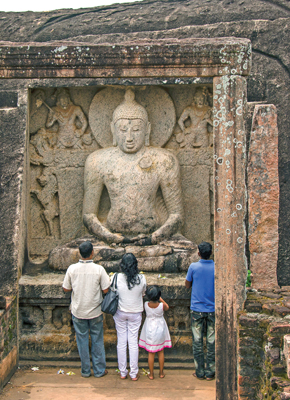
The seated Buddha statue hewn into the rock boulder
Most villagers are farmers who left the area during that troubled period and have now returned and settled in their ancestral lands. Farmers are busy again and acres of lush paddy fields are a relaxing sight. I first visited the Thanthirimale sacred site in 2002 after the Ceasefire Agreement was signed between the UNP Government and the LTTE.
We never miss to visit this ancient Buddhist Vihara on our journey to Anuradhapura each year. On our recent visit, we saw that the lifestyle of the villagers has changed in an unimaginable fashion.
Travelling 40 kilometres on the Anuradhapura-Thanthirimale Road, we saw farmers drying maize along the edge of the road under the scorching sun and children with their mothers bathing in village tanks that were covered with lotus flowers blossoming beautifully. The whole landscape was enriched by lush greenery.
Significance
The ancient Thanthirimale Raja Maha Vihara in Anuradhapura has a history that links it to the celebration of Poson Poya, the day Ven. Arahat Mahinda Thera elucidated the Dhamma to King Devanampiyatissa and introduced Buddhism to Sri Lanka.
Thanthirimale was first developed by a minister of King Vijaya called Upatissa who chose this site surrounded by the Malwatu Oya to build his future city and named it as Upatissa Grama. King Vijaya is believed to have met Kuveni in the jungle of Wilpattu where the ruins of a stone mansion belonging to Kuveni can still be seen in the adjoining Wilpattu National Park.
It might be interesting to note how the name Thanthirimale originated.
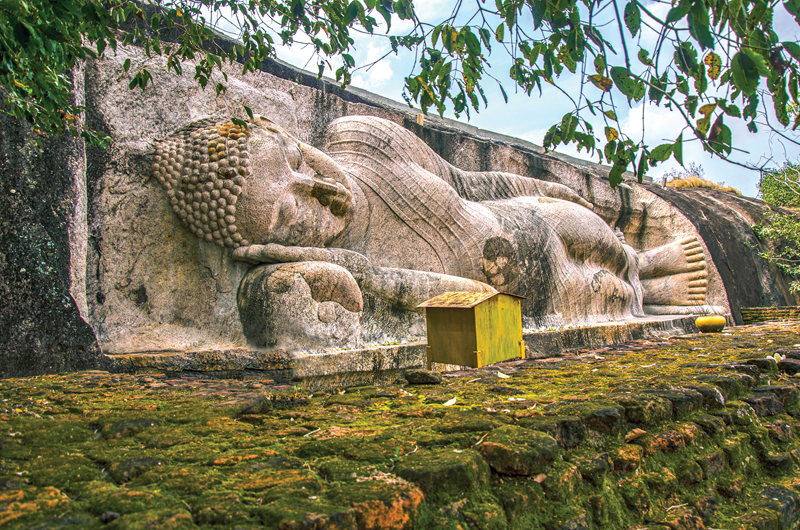
The reclining Buddha statue hewn into a rock
When Prince Vijiya arrived in Thambapanni, he had advised his followers to establish settlements in different areas. According to his advice, a minister known as Upatissa has set up a settlement in this area. Thus, this area was once called Upatissa Grama.
History has it that when King Devanampiyatissa first visited Thanthirimale, it was known as – Tiwakka Bamunugama, home to a Brahmin known as Tiwakka.
The sequel to the arrival of Ven. Arahat Mahinda Thera and subsequent cultural revival, the people of the area became followers of Buddhism. It is believed that the Bodhi tree at Thanthirimale is a sprout of the sacred Bo sapling planted in Mahamevna in Anuradhapura.
The story goes thus.
Emperor Ashoka, commissioned his daughter, Bhikkhuni Sangamitta, to take a sprout of the Sacred Bo Tree in Bodhgaya, under which the Buddha attained Enlightenment, to Sri Lanka. Bhikkuni Sangamitta and her entourage had supposedly rested at Thanthirimale on their way to Anuradhapura. The following day on their arrival in Anuradhapura, the group was welcomed by King Devanampiyatissa and his followers to the garden of Mahamevna.
They discovered that the Sacred Bo sappling had miraculously produced eight more saplings, of which one had been presented to the sage Thivakka.
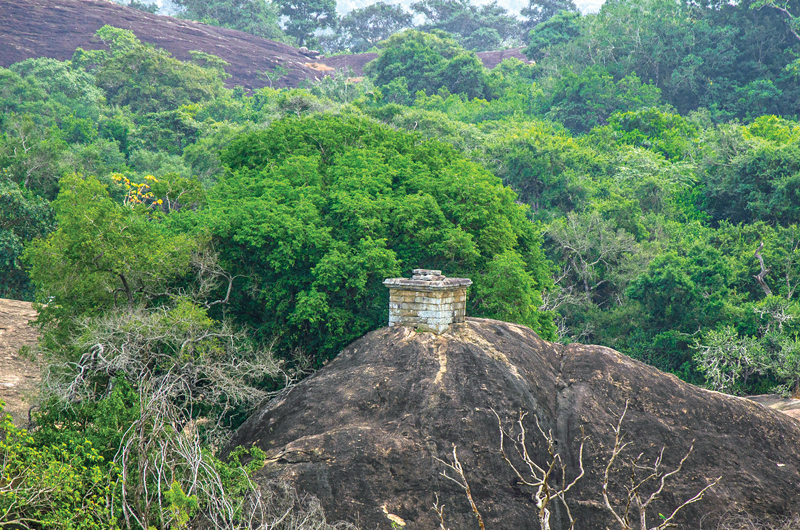
The Pothgula with a chimney-like enclosure at the summit of a rock
He carried the sapling majestically to Thanthirimale and had it planted and protected by a circular wall made of rock. In commemoration of that great day in history and the temple’s association with the event, a special significance is accorded to the sacred precincts of Thanthirimale during the Poson festive season. The temple is a repository of history and art, aptly displayed in the ruins and carvings found at various places in the temple premises.
Spread across closely strewn rock surfaces surrounded by dense jungle, the genesis of this ancient temple is traced to Third Century BCE. Used in later years as a monastery, Thanthirimale is renowned for its many caves, inscriptions, carvings, ruins of monastic residences, meditation chambers, a library and of course, the Sacred Bo tree. Also of significance is the eight-foot image of the Buddha carved on rock and encircled by a decorative arch known as Makara Thorana, borne by two lions.
The beauty of the image of the reclining Buddha engraved out of natural rock demonstrates distinctive detail to the robe and its drape.
Library known as Pothgula
The library known as the Pothgula has a rectangular chimney-like enclosure at the summit of a rock. Inside, ola leaf manuscripts have been stored, protected by a roof. There are ruins of at least twelve buildings used as meditation rooms and residences by bhikkhus. Built on rock, the legacy of Thanthirimale has endured the vagaries of time and borne the assaults of marauding elements.
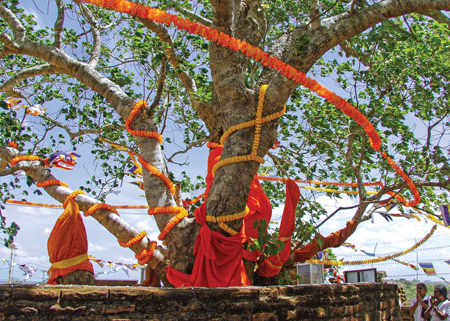
The sacred Bodhi tree on the summit of the rock
In 1960, the Thanthrimale historical site and the village were renovated by the founding bhikkhu of the Thanthirimale Raja Maha Vihara and Chief Incumbent of the North and the East Ven. Kudakongaskada Wimalagnana Thera who got down families from areas such as Medawachchiya and Vavuniya to settle down in the village surrounding the temple. The Thera cleared a part of the jungle and got the tanks repaired to build a settlement.
In the days gone by, it was a thick jungle and no one knew that this place had even existed. The temple and the village came under LTTE attack several times including the 1992 bomb blast which claimed the life of the then Chief Bhikkhu.
The present Chief Incumbent, Ven. Thanthirimale Chandrarathana Thera is committed to developing and restoring the temple into its past glory and uplifting the living conditions of the farming families in surrounding villages.





